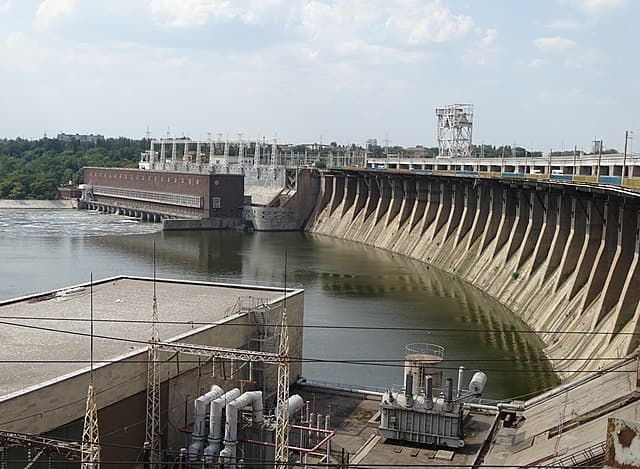Dams of the Dnipro Cascade Could Become Targets of Russians
Vast flood could be unleashed against Kyiv.

How can Russia escalate its war against Ukraine? After losing 3,000 tanks, 6,000 armored personnel carriers, and 100,000 soldiers, the Russian Army has been cut in half. After losing two Black Sea flagships, the Russian Navy shelters in Sevastopol harbor.
After losing 281 jet fighters and bombers, the Russian Air Force no longer ventures into Ukrainian air space. After firing 1,000 cruise missiles into Ukraine, the Kremlin is running low. One force multiplier that keeps Ukrainian strategists up at night is dam busting — with conventional or nuclear weapons.
During the Communist era, Soviet engineers built a north-south succession of six dams across the Dnipro, Europe’s second longest river, after the Danube. Known as the “Dnipro Cascade” this string of hydroelectric power stations supply only 10 percent of Ukraine’s power, in normal times.
Since October 10, though, Russian drones and cruise missiles have damaged or destroyed all of Ukraine’s coal, gas, or oil-fired power plants, according to Ukraine’s Energy Ministry. Now, Ukrainian strategists fear, the Kremlin may turn their attention to the dams across the Dnipro, a river about half the length of the Mississippi.
The most powerful blow would be to the top of the cascade — the Kyiv Hydroelectric Power Plant. Situated 15 miles north of the capital, the dam holds back a reservoir so large that it is called “the Kyiv Sea.”
A breach of this dam, built in the 1960s, would unleash on Kyiv a volume of water almost as great as all the water in New York’s Lake Champlain.“If the dam is destroyed, the flood would lead to catastrophic casualties and damage — in particular, to the flooding of residential areas of Kyiv and the suburbs,” reads a press statement from the waterways agency, part of the Infrastructure Ministry.
The agency said that if the Kyiv dam breaks, the surge would break the first two dams downriver, in Kaniv and Kremenchuk. A break in the Kyiv dam “will lead to the destruction of Obolon, Podil and the entire left bank of Kyiv,” estimates Interfax Ukraine.
Since then, Ukraine’s government has not reported attacks on the dams. The last dam in the series, Nova Kakhovka, has been controlled by Russian soldiers since last spring. The Russians have opened a side sluice gate to restore flows of irrigation water to Crimea, the semi-arid Ukrainian peninsula controlled by Russia since 2014.
Until the war started, all six dams across the Dnipro carried road traffic and several carried train traffic. Destroying dams to win advantage in war is not new. Russia’s Defense Ministry planners are well aware that in 1941 retreating Red Army soldiers blew up the Zaporizhia dam, then the only dam across the Dnipro.
The flood surge killed up to 100,000 civilians down river, as well as dozens of Soviet soldiers and officers who were fleeing across at the time of the explosion. Known as Dnieprostroy, the dam was the largest in the world at the time of its construction, in the late 1920s.
“Dnieprostroy was an object almost of worship to the Soviet people. Its destruction demonstrates a will to resist which surpasses anything we had imagined,” American journalist H.R. Knickerbocker wrote in late 1941. “It was the largest, most spectacular, and most popular of all the immense projects of the First Five-Year Plan.”
Two years later, when the fortunes of war changed, retreating German soldiers again dynamited the dam. On the Western Front, Britain’s Royal Air Force carried out a bombing raid in May 1943 against two dams in the Ruhr Valley, Germany’s industrial heartland.
This fall, Ukraine air defense has improved its kill rate — shooting down 80 percent of incoming Russian missiles, from 50 percent two months ago. Of the barrage of 76 fired at Ukraine Friday morning, 60 were shot down — 79 percent. But Energy Minister German Galushchenko said at least nine power-generating facilities were hit.
The worry is that if a barrage of Russian cruise missiles is aimed at the Kyiv dam, one might get through. Or that President Putin will follow through on his threat to go nuclear.
To beef up Ukraine’s air defenses, Biden Administration officials told reporters in Washington this week, America will provide Ukraine with Patriot surface to air guided missile systems. These truck-mounted, radar equipped systems are considered a major step for Ukraine’s self defense.

